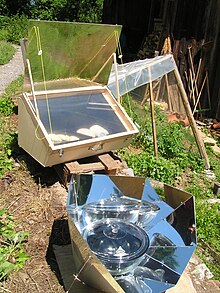Cooking without the need for firewood or gas, is now possible, thanks to solar energy. Indeed, more and more people are choosing to try solar cooking in their homes, especially in regions with greater solar exposure. What makes it an environmentally friendly alternative is its independence from gas or electricity.
In these solar cookers or ovens, it is possible to cook any type of food, whether vegetables, meats, or even desserts, using the natural heat provided by the sun.
By the way, this method is nothing new, as its origins date back to 1767, when the Swiss naturalist and physicist Horace de Saussure carried out the first research and prototypes of solar stoves.
The scientist discovered that among its multiple advantages were the ability to maximize the use of solar radiation, as well as to eliminate the emission of polluting gases. Furthermore, it helps reduce the risk of fires, making the cooking experience safer.
 Solar cooker, an ecological alternative. Photo: Wikipedia.
Solar cooker, an ecological alternative. Photo: Wikipedia.
The advantages of using a solar cooker
Solar cookers use solar radiation as an energy source to cook different types of food and pasteurize water, contributing to the reduction of easily preventable diseases, saving time, money, and environmental damage. Additionally, they have the following advantages:
- They do not need any type of fuel to operate.
- They are built with common and inexpensive materials.
- They are a good alternative for people with few resources, saving money.
- Easy to use, although they require an adaptation period.
- Multiple uses such as defrosting food, melting wax for candles, fruit preservation, boiling water, as well as making paper or soap, among others.
 Eco-friendly stove. Photo: Wikipedia.
Eco-friendly stove. Photo: Wikipedia.
How does it work?
These cookers operate based on solar radiation, which is captured and converted into heat. In fact, there are different models ranging from parabolic to panel cookers, which can reach temperatures of up to 200 degrees.
These devices were designed to retain heat, allowing for slow and uniform cooking, as if cooking at a low temperature. This type of cooking is ideal for recipes that require long and slow cooking processes, such as stews, soups, and casseroles, as well as brownies and pies.
The key to ideal cooking is to place the cooker in a location that receives sunlight for several hours, avoiding shadows and ensuring it is directly facing the sun. Dark pots and containers should also be used to maximize heat absorption, and patience is required, as this method takes longer than usual, although the result is just as delicious as traditional cooking.
Do you already know our YouTube channel? Subscribe now!

